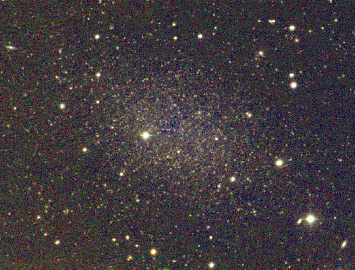 We have discovered a new member of the Local Group of Galaxies in the
constellation of Cetus. The Cetus dwarf is important because it is one of a
very select club of isolated Local Group members.
We have discovered a new member of the Local Group of Galaxies in the
constellation of Cetus. The Cetus dwarf is important because it is one of a
very select club of isolated Local Group members.
 We have discovered a new member of the Local Group of Galaxies in the
constellation of Cetus. The Cetus dwarf is important because it is one of a
very select club of isolated Local Group members.
We have discovered a new member of the Local Group of Galaxies in the
constellation of Cetus. The Cetus dwarf is important because it is one of a
very select club of isolated Local Group members.
Most Local Group galaxies are satellites of the Milky Way and Andromeda systems leaving only a few outliers to use as probes of the dynamical evolution of the Local Group and for characterising the unperturbed evolution of nearby dwarf galaxies.
Astronomers had previously overlooked the galaxy because of its low surface brightness relative to the night sky.
The discovery was made by, Dr. Alan Whiting of the US Navy, Dr. George Hau , of the Pontificia Universidad Catolica de Chile, and Dr. Mike Irwin of the Institute of Astronomy in Cambridge, and was made public on 4th June 1999 at the 194th American Astronomical Society meeting in Chicago. A visual inspection of 894 UK Schmidt Telescope photographic survey plates covering the entire Southern sky had been used to discover many previously uncatalogued large, diffuse low surface brightness objects. Digitisation of these candidates on the Royal Greenwich Observatory PDS microdensitometer confirmed their potentially interesting nature and followup deep CCD imaging on the 1.5m telescope at CTIO and at the 2.5m Isaac Newton Telescope on La Palma, showed that one of these objects clearly resolved into stars. The red giants visible in the Cetus dwarf place it well within the Local Group.
Photographs
V,R,I-band CCD images were combined to produce a pseudo-colour images of Cetus . The brightest stars of Cetus (neutral colour) are easily resolved placing it comfortably within the boundaries of the Local Group.
Return to index